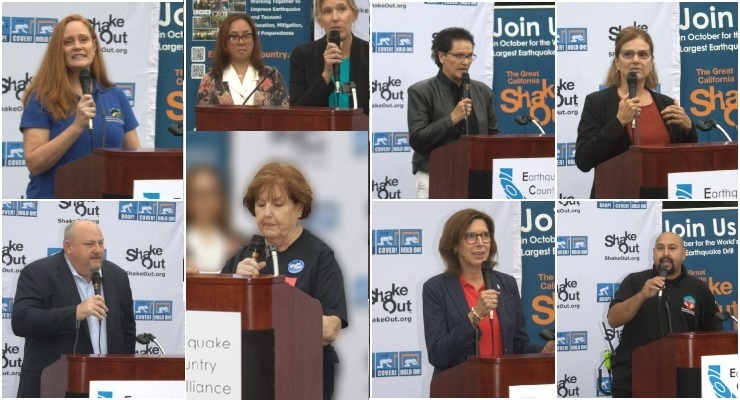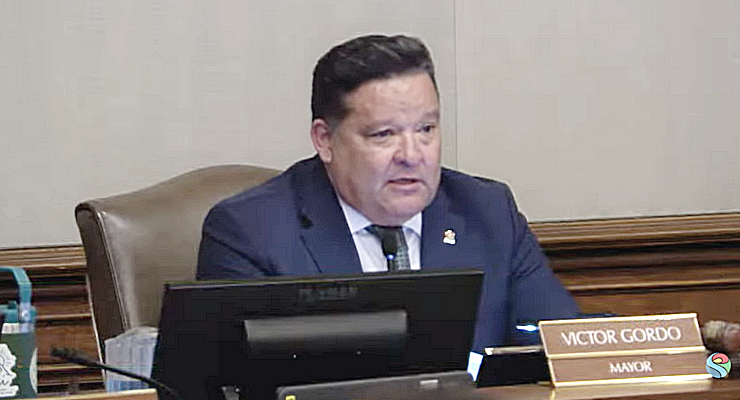
(Top row images, left to right) Wendy Bohon, Melanie Jocelyn, Sherri Sarro, Janiele Maffei. (Bottom row images) Robert Fenton, Margaret Vinci, Joanne Nowlin, Michael Martinez. [Therese Edu/Pasadena Now]
California demonstrated its cutting-edge approach to earthquake readiness on Thursday, October 17 when more than 10 million residents participated in the annual Great ShakeOut drill. The event, which took place precisely at 10:17 a.m., showcased the state’s commitment to disaster preparedness through a combination of advanced technology and widespread community involvement.
In a city like Pasadena, home to the California Institute of Technology and its renowned seismology lab, and situated near several fault lines, earthquake preparedness is an ongoing critical concern.
“Earthquakes are unique natural hazards because they strike without warning,” said Robert J. Fenton Jr., Regional Administrator for Region 9, Federal Emergency Management Agency, during the 2024 Southern California Primary ShakeOut Media Event. “There’s no time to prepare when the ground starts shaking, which makes events like this Great ShakeOut all the more important.”
The event featured a Big Shaker Earthquake Simulator, capable of recreating earthquake intensities up to magnitude 8.0 on the Richter scale. Participants practiced the “Drop, Cover, and Hold On” technique, reinforcing crucial safety measures for when an actual earthquake strikes.
The event also included demonstrations of Southern California Edison’s Laydown Yard response equipment and the Seven Steps to Earthquake Safety.
Southern California Edison, a key player in the region’s disaster resilience efforts, showcased its emergency response capabilities.
“Over the past eight years, we have invested more than 250 million in resiliency,” said Melanie Jocelyn, Business Resiliency Director at Southern California Edison. “A prime example of that is the work completed on 50 of major transmission substations, including those closest to the San Andreas Fault.”
The event also highlighted the ShakeAlert system, an earthquake early warning technology developed by the U.S. Geological Survey and its West Coast partners, including Caltech. This network of 1,100 seismic stations can detect earthquakes quickly and issue alerts before shaking reaches populated areas, providing crucial seconds for protective actions. The system can warn of earthquakes of magnitude 4.5 and above, with an intensity of 3 or higher at the user’s location.
Margaret Vinci, Manager of the Office of Earthquake Programs at Caltech, emphasized the importance of such preparedness efforts: “We sometimes take our utilities for granted and often forget how much they affect our daily lives and we depend on them. The earthquake exercise you conducted today is an example of the process of being prepared the best that you can be.”
Caltech plays a significant role in ShakeAlert’s development and operation, including maintaining part of the California Integrated Seismic Network.
The ShakeOut event was not just about technology; it also focused on individual and community readiness.
Organizers, including the Federal Emergency Management Agency, the California Office of Emergency Services, and the Red Cross, encouraged Californians to create family emergency plans, assemble emergency kits, and download early warning apps like MyShake.
Janiele Maffei, Chief Mitigation Officer at the California Earthquake Authority, highlighted available resources for homeowners.
“We have absolutely successful retrofit systems and then I’m very excited to report. We have two grant programs to help Californians with these retrofit systems.”
These programs help homeowners retrofit their houses against earthquake damage.
The drill also addressed the needs of vulnerable populations.
“Being able to live independently means being able to be self-reliant. And unfortunately, most of us want to rely on other systems to do all the work for us,” said Michael Martinez, Planning and Response Coordinator for Disability Disaster Access and Resources for LA City and County.
Sherri Sarro from the California Office of Emergency Services noted, “Although California is always at the cutting edge of technology, we do not have the ability to predict earthquakes.”
The Red Cross was also actively involved, with Joanne Nowlin, Regional CEO of Red Cross LA region, stating that they have over 4,000 trained volunteers in LA ready to assist in case of an emergency.
“There’s a saying that we learn geology the morning after the earthquake, and historically that has been true,” observed Wendy Bohon, Branch Chief of Seismic Hazards and Earthquake Engineering at the California Geological Survey. “Exercises like this one put on by Southern California Edison … are moving us from a reactive stance into a proactive stance and all of us need to be a part of that.”


















